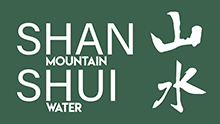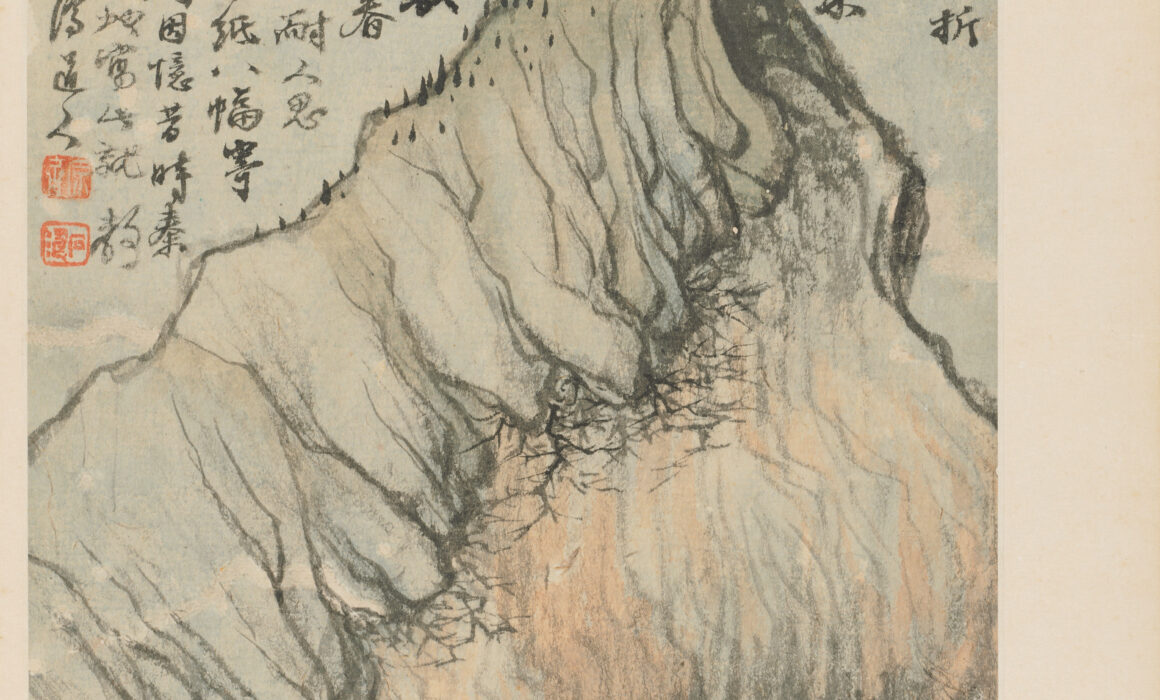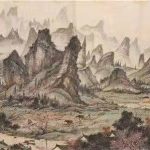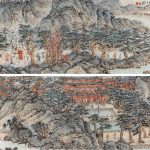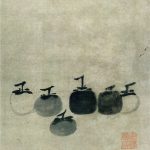The bifa concept in Jing Hao’s Bifaji
Issue 1 – Author: Claudio D. Lucchi
A brief study of its continuity and significance in Mountain and water painting (Part I)
Chinese ink-wash painting (shuimo hua 水墨畫) was already practiced during the Tang dynasty. Since then, this particular art form has never ceased to develop. Carefully handed down from one generation of painters to the next, treated like a rare and precious flower by Chinese painters and literati alike, Chinese ink-wash painting has always been (and still is today) a topic of discussion.
Shuimo hua’s long history per se already reflects philosophical concepts concealed deep inside the life view of the culture that created it. This fact becomes even more intriguing when one compares Chinese painting to its Western counterpart, whose history has more than once been marked by schisms and revolutions.
The concepts and theories underlying these two art systems, as well as the philosophical principles on which they rest further reveal, albeit often dimly and only partially, the unfathomable chasm which separates them.
One of these concepts, bifa 筆法, was discussed at length by Jing Hao 荊浩 in his treatise, the Bifaji 筆法記 (translated into English by Kiyohiko Munakata as Ching Hao’s Pi-fa-chi : A Note on the Art of the Brush).
Through the present paper, I have explored this unique concept, endeavouring to single out the key role it plays in mountains-and-waters painting (shanshui hua 山水畫), trying to grasp its philosophical fundamentals and dual — mystical and transcendental, on one side, rational and technical, on the other (see below) — nature. While doing so, I found it relevant to compare various notions inherent to Chinese philosophy with precepts developed within Christian thought. This proved helpful in demonstrating why Jing Hao’s bifa would lose its significance if applied to Western painting.
1. Introduction: Chinese and Western perspectives in Chinese painting studies
At first glance, Chinese pictorial literature distinguishes itself mainly in two respects : its long history, which spans over two millennia, and its fecundity. These bear witness to the historical continuity and unhurried germination of Chinese ink-wash painting.
The large number of treatises and anthologies shows a desire to perpetuate a tradition based on the transmission, from one generation to the next, of a cultural heritage conscious of its historical responsibility.
This impressive literary corpus has been arousing Western scholars’ interests for a few centuries.. As a result, a great variety of high-quality translations, commentaries, and research papers are available to modern art students, allowing them to expand their intercultural experience by comparing and cross-referencing original Chinese texts and their translated versions.
In the field of intercultural studies, it is practically impossible to place Chinese and Western painting side by side in order to conduct a comparative analysis. This is mainly due to the considerably different systems of thought which affect them and on which they have gradually come to rest, and the cultural environments in which they endlessly evolve.
This does not mean that comparative studies of any kind are pointless. When judiciously applied, they do indeed present a great interest as they allow researchers and readers alike to gain a better understanding not only of other cultures but also of their own selves, for it is often through the eyes of others that our true self is revealed.
However, when engaging in such studies, particular attention should be brought to historical, cultural, and philosophical backgrounds. When comparing Chinese and Western painting, each should be kept in its own context, thus leading to a sort of parallel comparison. The rendering of ancient Chinese terms in Western languages is but one of the most obvious difficulties present in the field. How can one, for instance, translate the Chinese aesthetic term shen 神 into divine, or qiyun shendong 氣韻生動 into spirit resonance, without properly explaining its original semantic value ? Obviously, the context attached to each word is just as significant as the context of the facts discussed.
2. The Bifaji 筆法記 and its bifa 筆法 concept
Among pictorial treatises, anthologies of painters, treatises on the history of ancient art, and collections of critical essays, some texts distinguish themselves through their formal originality, as well as the innovative nature of the concepts they propose. In this context, the Bifaji 筆法記, commonly attributed to Jing Hao 荆浩, occupies a prominent position due to its development of the bifa 筆法 concept and its influence on the further development of Mountain and water painting, or shanshui hua 山水畫.
The Bifaji’s sphere of influence appears to have already spread far beyond China’s borders. This is highlighted by at least five translations into English, one in Japanese, and two studies, also in Japanese; not to mention its reproduction in other works devoted to Chinese pictorial art. Hence, more than a thousand years after its composition, the Bifaji is still actively read, studied, and analysed.
From a purely linguistic standpoint, the term bifa already constitutes a challenge in itself. In his translation of the Bifaji, the Japanese scholar Kiyohiko Munakata rendered the term as “art of the brush”, while the Italian scholar Maurizio Paolillo interpreted it as “Ars pingendi”. While bi 筆 translates rather easily as brush or writing tool, the meaning of fa 法 is vaster and more profound, and may be rendered as law or method, or even as dharma in a Buddhist context (佛法). Linguistically, Paolillo and Munakata’s translations may both be deemed as correct. Munakata’s “art of the brush” does however offer a more comprehensive meaning, while Paolillo’s “Ars pingendi” appears to concentrate itself on the creative act in painting.
This leads to a second consideration: in a Western context, any painting brush or tool could not possibly be associated with anything more than concepts of method or technique. For Western painters, a painting brush is a tool that allows them to express their ideas. Its materials and shape may matter little as long as it yields the desired result. Following this principle, it becomes clear that any possible Western brush method falls under the much more important discourse about the relationship between form and content, as was for instance discussed by Wassily Kandinsky in his essay Über die Formfrage and his book Über das Geistige in der Kunst. Following Kandinsky’s ideas, form has to be regarded by the artist as the spirit’s vessel. The choice of a particular form in a given work is thus defined by the spirit the artist wishes to express. How and by what means the desired form is to be attained is entirely left to the artist and is, in a certain way, secondary since all means and efforts must finally lead to one goal, i.e., the spirit.
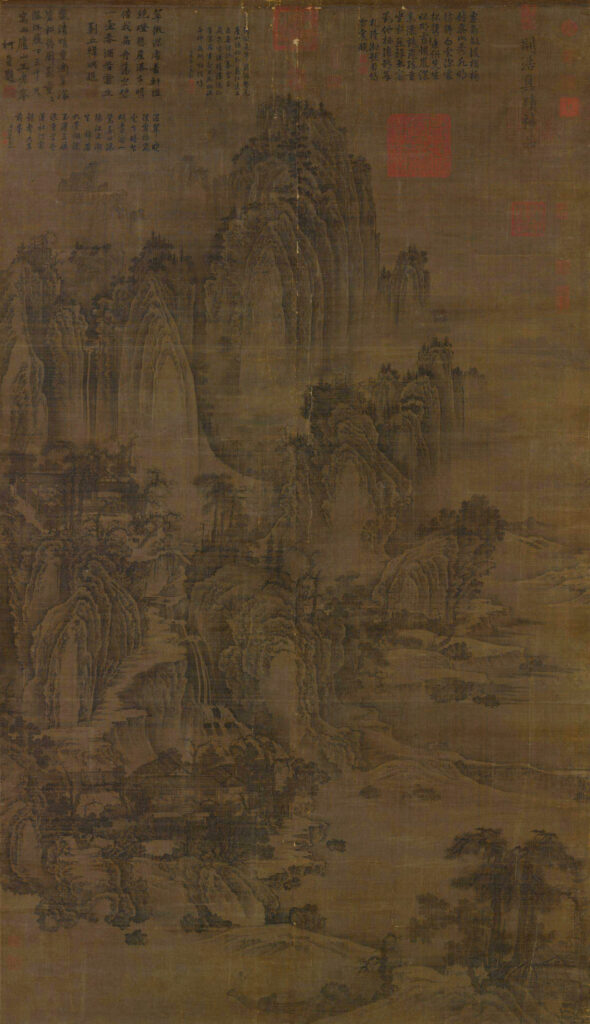
This is far from being the case in Chinese painting. Throughout its history and up to our present day, various painters have written extensively on the handling of the brush, bringing special attention to brush strokes, their strength and variation, expression of particular feelings and philosophical concepts, wrist movement, etc. What rapidly transpires as one progresses through the numerous texts written on this subject is that in Chinese painting, bifa is far more than a mere technique or set of rules. It becomes equally clear that its role in Chinese painting is essential and that the philosophical concepts it rests upon are not limited to the painting field.
2.1. Key role of the bifa 筆法 concept
As the author of the Bifaji first raises the question of bifa, he does so in a most particular way :
The old man said : “If you, a young man, like to study, you can accomplish it in the end. Now, there are Six Essentials in painting. The first is called Spirit (qi 氣). The second is called Resonance (yun 韻). The third is called Thought (si 思). The fourth is called Scene (jing 景). The fifth is called Brush (bi 筆). And the sixth is called Ink (mo 墨).”
I said, “Painting (hua 畫) is equivalent to flower [or outward appearance] (hua 华). That is to say, one obtains reality when he devotes himself to attaining lifelikeness. How could this [simple truth] be distorted ? The old man answered : “Not so. Painting (hua 畫) is equivalent to measuring (hua 畫). One examines the objects and grasps their reality. He must grasp the outward appearance from the outward appearance of the object, and the inner reality from the inner reality of the object. He must not take the outward appearance and call it the inner reality. If you do not know this method [of understanding truth], you may even get lifelikeness but never achieve reality in the painting.
叟曰,少年好学,终可成也。夫画有六要:一曰气;二曰韵;三曰思;四曰景;五曰笔;六曰墨。曰,画者,华也,但贵似得真,岂此窍矣。
叟曰,不然,画者,画也。度物象而取其真。物之华,取其华。物之实,取其实,不可执华为实。若不知术,苟似可也,图真不可及也。
This short passage illustrates the fact that painting is far from being an end to itself. It does in fact derive and rely on philosophical concepts concerning perception, reality, and how man interacts with the world in general, already established and discussed before the Christian era by Confucian and Taoist philosophers alike. From a Western standpoint, it becomes crucial to familiarise oneself with these notions, as they constitute the very foundation of the Chinese system of thought, especially since they differ significantly from their Western counterparts.
In the Six Essentials (liuyao 六要) outlined by Jing Hao, bi [brush] comes only fifth in rank and yet, it must not be regarded as an independent concept but rather as a vital organ within an organic whole. This is pointed out a little further:
Here I will give the detailed instructions of the Essentials of painting. Spirit (qi 氣) is obtained when your mind moves along with the movement of the brush and does not hesitate in delineating images. Resonance (yun 韻) is obtained when you establish forms while hiding [obvious] traces of the brush, and perfect them by observing the proprieties and avoiding vulgarity. Thought (si 思) is obtained when you grasp essential forms eliminating unnecessary details [in your observation of nature], and let your ideas crystallize into the forms to be represented. Scene (jing 景) is obtained when you study the laws of nature and the different faces of time [different times of the day or seasons of the year], look for the sublime, and recreate it with reality. Brush (bi 筆) is obtained when you handle the brush freely, applying all the varieties of strokes in accordance with your purpose, although you must follow certain basic rules of brushwork. Here you should regard brushwork neither as substance nor as form but rather as movement, like flying or driving. Ink (mo 墨) is obtained when you distinguish higher and lower parts of objects with a gradation of ink tones and represent clearly shallowness and depth, thus making them appear as natural as if they had not been done with a brush.
图画之要,与子备言;气者,心随笔运,取象不惑;韵者,隐迹立形,备仪不俗;思者,删拨大要,凝想形物;景者,制度时因,搜妙创真;笔者,虽依法则,运转变通,不质不形,如飞如动;墨者,高低晕淡,品物浅深,文采自然,似非因笔。
Qi 氣 [spirit], yun 韻 [resonance], si 思 [thought], jing 景 [scene], and mo 墨 [ink] are all linked to bi 筆 [brush]. Although they may theoretically exist each for itself, it is only through bi that they may reach organic unity. In such a context, bi cannot be treated as a painting tool or method [brushwork], neither be regarded as substance nor form “but rather as movement”, i.e., a form of creative energy that instills life and gives shape to all things within a painting.
An extract from the Lidai Minghua Ji 歷代名畫記 by Zhang Yanyuan 張彥遠 may help to better illustrate this concept:
Now, fashioned and distilled by [the interaction of] yin and yang, the myriad phenomena were strewn and spread [through the universe]. Mysteriously evolving without speech, [Nature’s] divine work operates by itself. Grasses and trees spread forth their glory without depending upon cinnabar and azurite; clouds and snow whirl and float aloft, and are white with no need for ceruse. Mountains are green without needing malachite, and the phoenix is iridescent without the aid of the five colors. For this reason one may be said to have fulfilled one’s aim when the five colors are all present in the management of ink [alone]. If one’s mind dwells on the five colors, then the images of things will go wrong.
夫阴阳陶蒸,万象错布,玄化亡言,神工独运。草木敷荣,不待丹碌之采;云雪飘扬,不待铅粉而白。山不待空青而翠,凤不待五色而彩。是故运墨而五色具,谓之得意。意在五色,则物象乖矣。
The painted scene here described is likened to the actual cosmos. When the Six Essentials are correctly and fully put into practice, the painting thus obtained is in fact a microcosm inhabited by the same vital breath (qi 氣) which animates the universe, built and functioning according to the same cosmic principle (li 理). A work thus created reaches a level of quality described by Jing Hao as divine (shen 神), i.e., a work “in which there are no artificial elements and the images are formulated spontaneously as the brush moves” (神者,亡有所为,任运成象). One may now better understand why the Jing Hao deems it so important that individual brushstrokes remain hidden within the painting : a painter in full command of the Six Essentials is actually experiencing “union with the universe”, thus modelling his creative activity on the Dao (道). As he paints, from his brush spring forth spontaneously, as if by themselves, the myriad beings (wanwu 萬物) that fill the universe. Everything happens naturally and effortlessly, and the painting, born from itself, shows no sign of human intervention, as if it were a natural part of creation. The brushstrokes that compose it remain hidden within the painted surface, thus rendering a sense of organic unity which symbolises the unity binding the myriad beings that make up the universe.
Through its union with the sixth Essential, i.e., mo 墨, the brush further symbolises the harmonious interaction of yin 陰 and yang 陽. As François Cheng explains in Vide et plein, while separated, yin and yang remain inert. It is only through their union that they may partake in the endless regeneration of the cosmos. The same happens with brush (yang) and ink (yin), who must operate in harmony so as to generate the myriad beings within the painting. François Cheng rests his explanation on Chapter VII of Shitao’s 石涛 treatise on painting Kugua Heshang Huayu Lu 苦瓜和尚畫語錄 :
L’union du pinceau et de l’encre est celle de Yin et Yun. La fusion indistincte de Yin et Yun constitue le Chaos originel. Et, sinon par le moyen de l’Unique Trait de Pinceau, comment pourrait-on défricher le chaos originel ? […] Réaliser l’union de l’encre et du pinceau, c’est résoudre la distinction de Yin et Yun, et entreprendre de défricher le chaos. […] Au milieu de l’océan de l’encre, il faut établir fermement l’esprit; à la pointe du pinceau, que s’affirme et surgisse la vie; sur la surface de la peinture s’opère une complète métamorphose; au milieu du chaos s’installe et jaillit la lumière! […] À partir de l’Un, l’innombrable se divise ; à partir de l’innombrable, l’Un se conquiert. La métamorphose de l’Un produit Yin et Yun — et voilà que toutes les virtualités du monde se trouvent accomplies.
The union of brush and ink is that of Yin and Yang. The indistinct fusion of Yin and Yang constitutes the original Chaos. But for the Unique Brushstroke, how could one clear up the original Chaos? […] Through the completion of the union of brush and ink, one uncovers the distinction that lies between Yin and Yang and one may then begin to uncover the chaos. […] One must firmly establish the spirit in the midst of the sea of ink. As life suddenly appears at the brush’s tip, a complete metamorphosis takes place on the painting’s surface; in the midst of chaos appears and springs forth light! […] Proceeding from One, the uncountable divides itseldf; proceeding from the uncountable, One may be conquered. One’s metamorphosis yields Yin and Yang, and the world’s possibilities find their accomplishment.
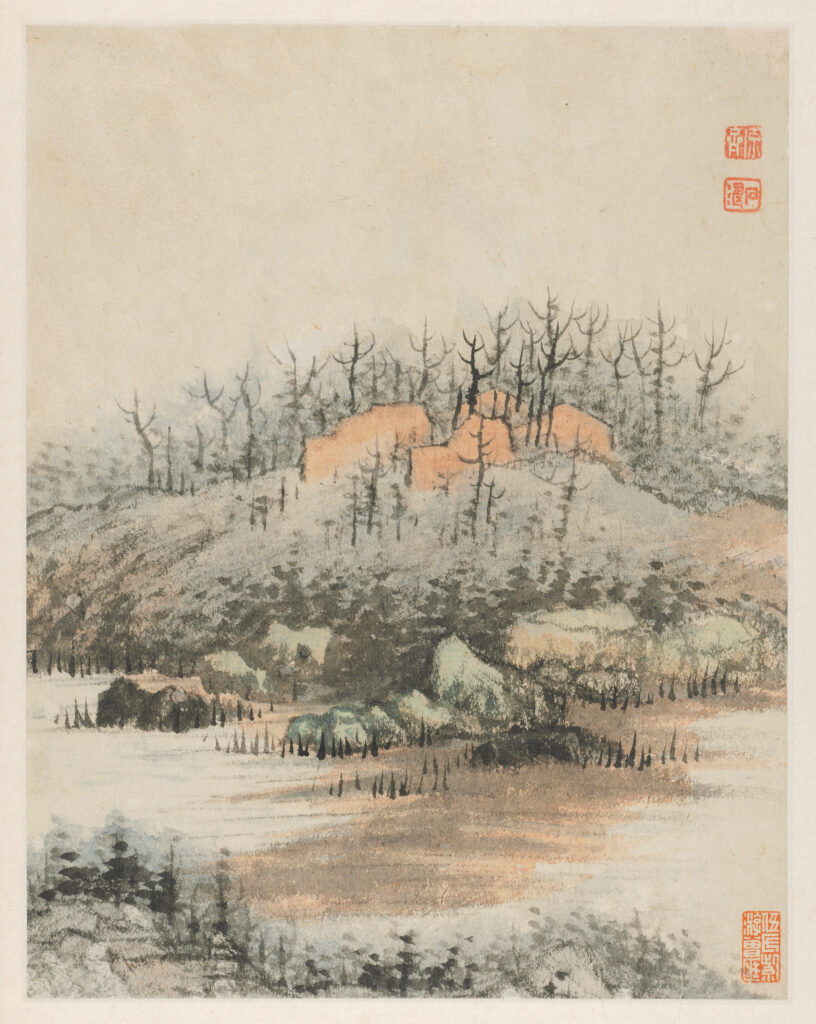
2.2. Cosmic view in the bifa concept
As it partakes in the process of cosmic regeneration, the painter’s bifa becomes a means to “investigate the hidden mysteries of Creation” and probe into man’s perception of reality.
The author of the Bifaji discusses the aim of painting in the following terms:
I said, “Painting (hua 畫) is equivalent to flower [or outward appearance] (hua 华). That is to say, one obtains reality when he devotes himself to attaining lifelikeness. How could this [simple truth] be distorted ? The old man answered : “Not so. Painting (hua 畫) is equivalent to measuring (hua 畫). One examines the objects and grasps their reality (zhen 真). He must grasp the outward appearance from the outward appearance (hua) of the object, and the inner reality (shih) from the inner reality of the object. He must not take the outward appearance and call it the inner reality. If you do not know this method [of understanding truth], you may even get lifelikeness but never achieve reality in the painting.” I questioned : “What do you call lifelikeness and what do you call reality (zhen 真) ?” The old man answered : “Lifelikeness means to achieve the form of the object but to leave out its spirit. Reality means that the forces of both spirit and substance are strong. Furthermore, if spirit is conveyed only through the outward appearance and not through the image in its totality, the image is dead.”
曰,画者,华也,但贵似得真,岂此窍矣。
叟曰,不然,画者,画也。度物象而取其真。物之华,取其华。物之实,取其实,不可执华为实。若不知术,苟似可也,图真不可及也。
曰,何以为似?何以为真?
叟曰,似者,得其形遗其气,
真者,气质俱盛。凡气传于华,遗于象,象之死也。
The discourse on the relationship existing between lifelikeness (si 似) and reality (zhen 真) is a very ancient one and plays a crucial role as it highlights the very significance of painting within the Chinese system of thought. In the Bifaji, the author proposes a harmonious balance between the object’s outer appearance [lifelikeness] and its inner reality, thus implying that like the universe itself, and every single element contained in it must be regarded as an organic whole, characterised by a dual physical-spiritual nature. Kiyohiko Munakata traced Jing Hao’s views back to Confucius, citing one particular passage from the Analects:
“Where the solid qualities (zhi 質) are in excess of the accomplishments (wen 文), we have rusticity; where the accomplishments are in excess of the solid qualities, we have the manners of a clerk. When the accomplishments and the solid qualities are equally blended, we then have the man of virtue.”
質勝文則野,文勝質則史。文質彬彬,然爲君子也。
Further insight into this topic might be gained through an excerpt from Zhu Jingxuan’s 朱景玄 Tangchao Minghua Lu 唐朝名畫錄 :
I have heard that men of old said that a painter is a sage; doubtless because he searches for that which is beyond heaven and earth, and reveals that which is unillumined by the sun and moon. When he wields a fine pointed brush, an endless variety of things issues forth from his mind. When he displays his talent within a square inch, a thousand miles lie within his grasp. As for conveying the spiritual (yishen 移神) while determining the material (dingzhi 定質), when the light ink falls upon white silk that which has physical appearance (xiang 象) is established, and that which is formless is created.
伏闻古人云:“画者,圣也。”盖以穷天地之不至,显日月之不照。挥纤毫之笔则万类由心,展方寸之能而千里在掌。至于移神定质,轻墨落素,有象因之以立,无形因之以生。
The Chinese world view, developed over two millennia ago, perceives the world through never-ending, self-regenerating natural phenomena. The universe has its dao 道, and all there is in it, its own principle. It is imperative that man does not disturb the natural order of the universe, which is perfect and self-functioning. He must on the contrary attune himself with Creation and thus enter in a harmonious state with the world. This is why balance, harmony, and the coherent coexistence of opposites are as much valued in everyday life as in Chinese painting. This makes it easier to explain why Chinese painting is also regarded as a kind of spiritual exercise which allows its practitioner to enter in harmony with the universe.
In this context, the crucial importance of bifa in Chinese painting is once again made evident. Nothing may happen without it: the ink would remain inert, and neither Spirit, Resonance, Thought or Scene could be obtained.
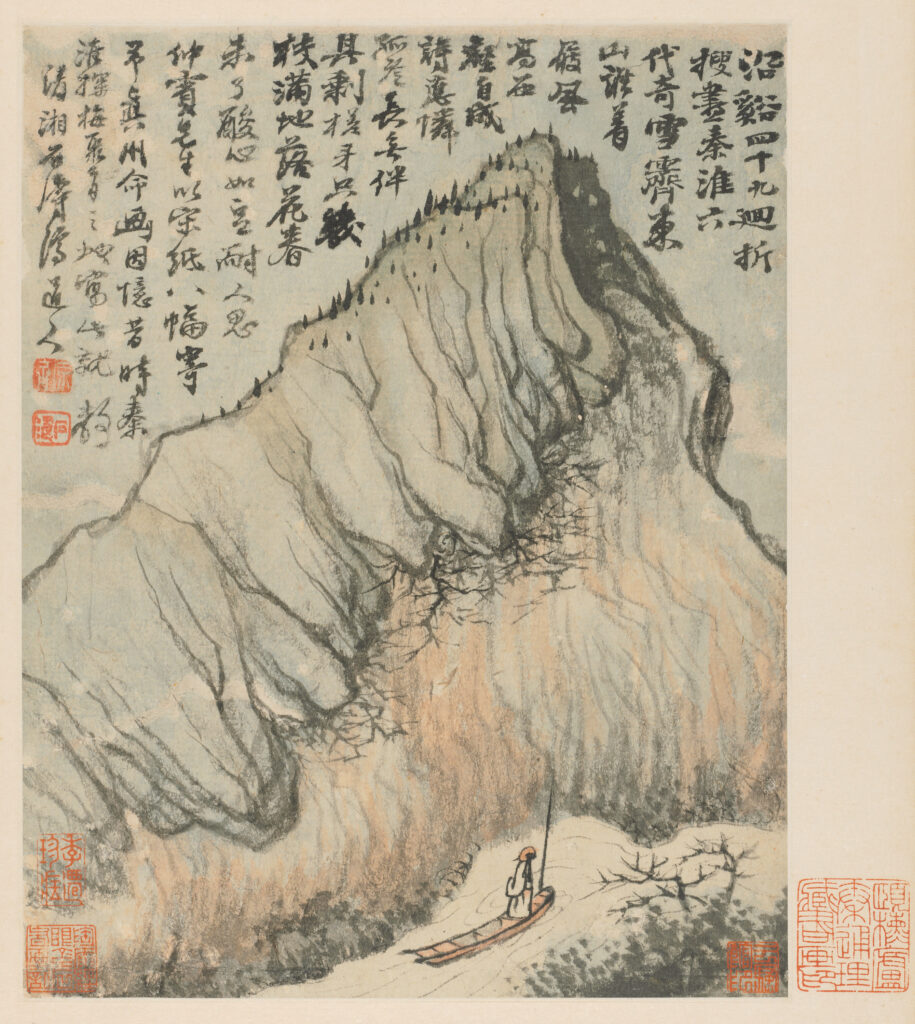
2.3. Bifa’s dual nature
In Chinese painting, bifa may be said to embody the Chinese outlook on the world and human life. In a world perceived as fluid and endlessly regenerating itself through constant changes, one must maintain an attitude towards life and artistic creation described by Vincent Yu-chung Shih (施友忠) as one of “flexible adaptability”. This requires “extreme sensitivity on the part of the artist or poet to the ever-changing situations and needs of the time” and calls for a guiding principle that is not easy to grasp, for it must rest on both knowledge and empirical truth, as well as intuition and natural talent. Under such circumstances, it becomes only natural that the very brushstrokes that make up a painting must be imbued with variation (bian 變), as these must express the painter’s emotional state.
Jing Hao clearly emphasises bifa’s dual character:
Brush (bi 筆) is obtained when you handle the brush freely, applying all the varieties of strokes in accordance with your purpose, although you must follow certain basic rules of brushwork.
笔者,虽依法则,运转变通……。
Although the handling of the brush itself rests on defined rules (虽依法则), these will not yield full mastery of the bifa concept. Technical perfection allows painters to create works that Jing Hao deems to be no better than distinctive (qi 奇) or skilful (qiao 巧). It may suffice to read the description of works belonging to the divine (shen 神) class in order to understand what the author considered to be the quintessence of creative experience in painting:
Divine work is that in which there are no artificial elements and the images are formulated spontaneously as the brush moves.
神者,亡有所为,任运成象……。
The artist’s state of mind here described may remind one of Vincent Yu-chung Shih when, talking of Zhuangzi’s concept of shen 神, he describes it as “a state which transcends both the human senses and the intellect, a state in which one forgets the entire world, including his own existence. In such a state, one attains that sudden enlightenment in which one experiences union with the universe. […] His concept of shen, when applied to the process of creation, led him to another vision which is equally mystical and equally transcendental, that is, the vision of an effortless creativity born of perfect understanding and comprehension.”
As one reads the Bifaji, the connection to Zhuangzi’s thought may be clearly felt. Jing Hao does however stress more than once that such an ultimate state of spiritual elevation may only be reached through a process of hard learning.
I wish you would keep working hard. [Truth is that] only when you reach the state of forgetting the technical matters of brush and ink, do you achieve the real landscape painting.
曰:原子勤之,可忘笔墨,而有真景,吾之所居,……。
It thus appears that bifa holds a dual nature : one mystical and transcendental, depending on the artist’s talent and intuition, and the other rational and technical, relying on the artist’s cognition and training.
Read the article from the magazine, download it from here
